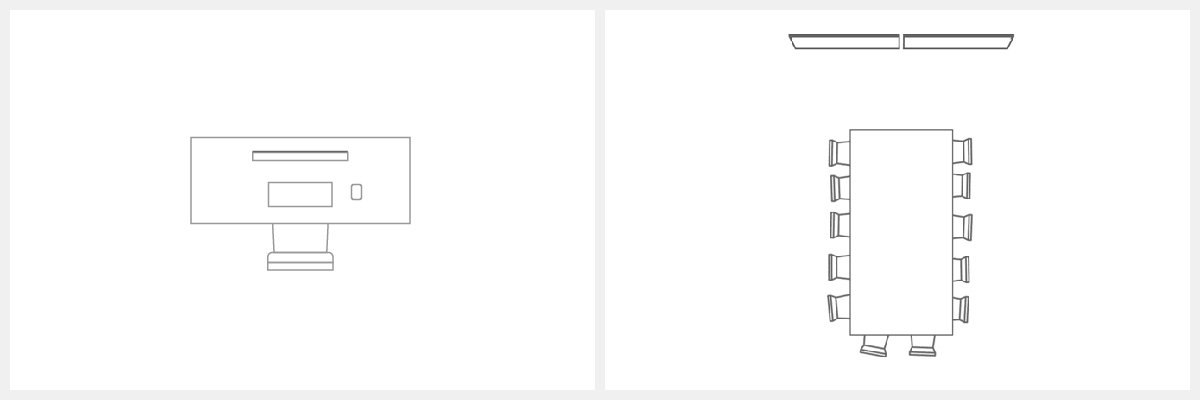How Much Does Video Conferencing Cost? A Breakdown of Virtual and Physical Setups.
Whether you are a business owner, employed by a company, or are a part of a small or large organization, the chances are that your day-to-day business operations have been affected by the global COVID-19 pandemic.
Finding a video conferencing solution that helps keep your team safe and operational is a significant decision and can end up being a considerable investment. Many businesses do not know what video conferencing services will cost them, nor how much the video conferencing products will cost.
This information is vital for you to know since the decision to incorporate a video conferencing solution will benefit your team’s workflow, communication processes, and collaboration efforts.
Here at LDI Connect, we integrate video conferencing products from the most reputable manufacturers globally and provide video conferencing solutions to support your business’s evolving challenges.
Our team of experienced LDI Connect Pro AV Specialists offers scalable solutions to help you integrate innovative AV technology for your business’ video conferencing needs. We understand how challenging it may be to choose a particular video conferencing product and service to fit your business’s goals – and we’re here to help you with the process.
This article will explain the factors that contribute to a video conferencing solution and service price. Although there isn’t one price that covers every video conferencing solution, by the end of this article, you will have many of your questions answered and be able to make an informed decision on what video conferencing product or service your business requires.
What Type of Video Conferencing Does Your Business Need?
Before looking at pricing, let’s break down whether your business needs a virtual or physical video conferencing setup. Depending on your specific business goals, the number of people you want taking part in a conference, and the technical equipment you already own, the price of your setup will vary.

Virtual Video Conferencing setup: If you’re looking to set up a video conferencing solution from the comfort of your own home with one or more people, then this would be labeled as a virtual setup. At most, a virtual setup requires either a smartphone, tablet, or PC and a free or paid application subscription.
Physical Video Conferencing setup: If your goal is to set up a video conferencing solution in your company’s conference room with two to twenty or more people, this would be a physical setup. Conference room solutions will vary due to the display size, devices, and extra accessories you wish to include.
Your conference room will need to reflect safe distancing, depending on your business’s reopening and safety strategy.
Keeping safety protocol in mind during the buying process is also essential and will affect your setup cost.
Now let’s dive into the top five factors that contribute to the cost of your video conferencing needs.
Five Major Video Conferencing Costs You Can Expect
There are five major video conferencing expenses to consider when thinking of implementing a reliable video conferencing solution. Let’s dive into a more in-depth explanation of the costs you can expect considering all the factors mentioned below:
1. Video Conferencing Application Subscriptions:

When it comes to communicating with your coworkers or with clients, the quality and reliability of your video conferencing application matter, a reliable video-conferencing application acts as the foundation of any video conference; thus, you can build on top of that foundation with certain products, accessories, and features.
Below is a list of four dependable video conferencing applications:
Zoom: Zoom works well in being one of the most dependable video-conferencing applications for large groups. You can download Zoom to both your computer and phone.
Zoom Cost:
Free for up to 100 people participating in a 40 minute or less meeting.
$14.99/Month per host plan includes unlimited meeting length, user management features, and reporting.
Google Meet: If you are a former G-Suite user, Google Meet might be your best option. Meet integrates well with Google’s other applications and makes the process of starting a meeting through your Google Calendar or Google Chat seamless.
Google Meet Cost:
Free for up to 100 people participating in a 60 minute or less meeting.
When joining a Google Workspace Basic plan, costs start as low as $6/month.
Microsoft Teams: If you already own a Microsoft 365 account, Microsoft Teams is an affordable option. Microsoft Teams is a single platform featuring messaging, video conferencing, screen-sharing, a calendar, and more. Microsoft Teams acts as a creative option for those looking to expand collaboration efforts throughout their team.
Microsoft Teams Cost:
Free for up to 100 participants in 60-minute meetings
Cisco WebEx: If you’re looking to whiteboard during a video conference, then Cisco WebEx may be the best option for you. WebEx’s virtual whiteboard enables large-scale collaboration with its vast array of sketch tools, geometric shapes, and text. Cisco WebEx includes all the features of a video conferencing application and has a Webex Teams application dedicated to fulfilling your team’s chat and one-click call needs.
WebEx Cost:
The Starter Plan begins at $14.95/Month for up to 50 participants per video conference.
2. Video Conferencing Devices To Consider:
When deciding what works for your conference room size and providing the best user experience possible, there are many devices to consider. Now that you’ve decided which video conferencing application to go with, you can have fun tailoring your setup with devices that fit your needs. Below is a list of devices that are necessary for conducting or joining a video conference:
Display: When researching the best monitors for your physical setup, factors to consider are the room size, display type, visibility, and mounting height. Video conferencing displays include the Liquid Crystal Display (LCD), the Light Emitting Display (LED), and the Front Projection. The display type is dependent on your video conferencing requirements.
To ensure that the video conference participants can see the data and content shared, consider utilizing a dual-display or multi-display setup to maximize screen real estate. The price range of any given display will increase depending on the size and LED effects your setup requires.
Sound: A separate sound system may enhance built-in speakers to improve the quality of a video conference. Most setups do not include a built-in microphone and require an external microphone or microphone system with echo cancellation. Displays with a functional built-in sound system will cost less than buying a separate sound system.
WebCams and Conference Cameras: Investing in a High-Definition (HD) option will provide a higher resolution to your setup, whether virtual or physical. Choosing a system that features a built-in HD camera, a separate HD camera with pan, zoom, and tilt would be best but may need more network bandwidth.
There is no shortage of options when deciding which camera to add to your particular setup. Whether the camera is HD or not, an external video conferencing camera can range anywhere from $200 to $3,000.
Mounting Height: Video calls act as a face-to-face alternative for conducting meetings; why not mount your display to be at eye-level? Bringing your display monitor’s height to eye-level will allow participants to feel comfortable when viewing the screen.
It will ensure that they are also looking at the camera lens when communicating with colleagues. While many multimedia stands are height adjustable, there are monitor stands sold separately to fit your video conferencing needs.
3) Installation:
The installation process will factor in your video conferencing application of choice and the products you’ve selected to make for an engaging and contactless video conferencing experience. Whether you choose to hire a company specializing in installing video conferencing equipment or choose to allow your IT department to help with the installation, options for installation vary in price. They are completely customizable depending on the size of your conference room.
4) Accessories, Features, and Add-Ons:
Within the last year, more and more businesses connect through video calls, and options for enhancing video quality have sky-rocketed. Below are three ways of improving the quality of your video conference:
- Accessories: Stands for your computer, and webcam computer can help you look your best. Prices can range from $20 to $200.
- Features: Applications such as Zoom and Microsoft Teams provide free lighting enhancement and virtual background options.
- Add-ons: Sprucing up your video conferencing calls with helpful add-ons such as Krisp, a noise-canceling tool, or Otter.ai, a live transcription tool that turns your spoken words into text. Prices for these add-ons can range from $3.33/Month to $30/Month, depending on the plan you choose.
5) Wi-Fi, Bandwidth, and Internet Speed:
Your Wi-Fi, bandwidth, and internet speed are all crucial to a video conference. Having an excellent Wi-Fi system to interface with the internet, bandwidth to transfer data at a high rate, and internet speed to access data and run an application is necessary when considering your video conferencing setup.
Cost and Decision: What’s Right For Your Business?
There are various factors to consider when deciding what video conferencing product or service to select for your business operations moving forward. One way of estimating your overall cost will be by calculating the number of people partaking in the video conference and the size of the room you will be using.
For example, if you are looking for a small-scale virtual setup for one or more people, then the price will range from $0 to $15 a month based solely on application subscription fees.
Suppose you are looking for a physical medium-scale setup for two to ten people within an average-sized conference room. In that case, prices can vary anywhere from $1,800 to $4,000, not including application subscription costs.
Finally, if you require a large-scale physical setup for twelve to twenty or more people, then the price can range anywhere from $5,000 to $10,000 or more depending on the particular devices you choose to fill up your large conference room.
Now that you know the five major factors that can influence cost within the video conferencing space and the rough estimates of various sized setups to expect, you have the information needed to have a detailed conversation about video conferencing products and services.
LDI Connect & Pro AV Services
LDI Connect offers an easy-to-use online meeting solution created for businesses of all sizes called LDI Elevate Meeting. Available on desktop and mobile devices, LDI Elevate Meeting ensures reliable team communication from anywhere at any time. Our Online Meeting Pro License plan starts at $15/Month for up to 100 participants, and our Enterprise User License starts at $18/Month for up to 200 participants.
LDI Connect’s Pro AV services team can provide you with the necessary knowledge and tools needed to conduct video conferences from home or work. Our Pro AV services team is well equipped to answer any questions about your video conferencing needs.
Find out more today about LDI Connect’s Pro AV services and learn more about how you can integrate these services to modernize your work environment with the latest video conferencing solutions.